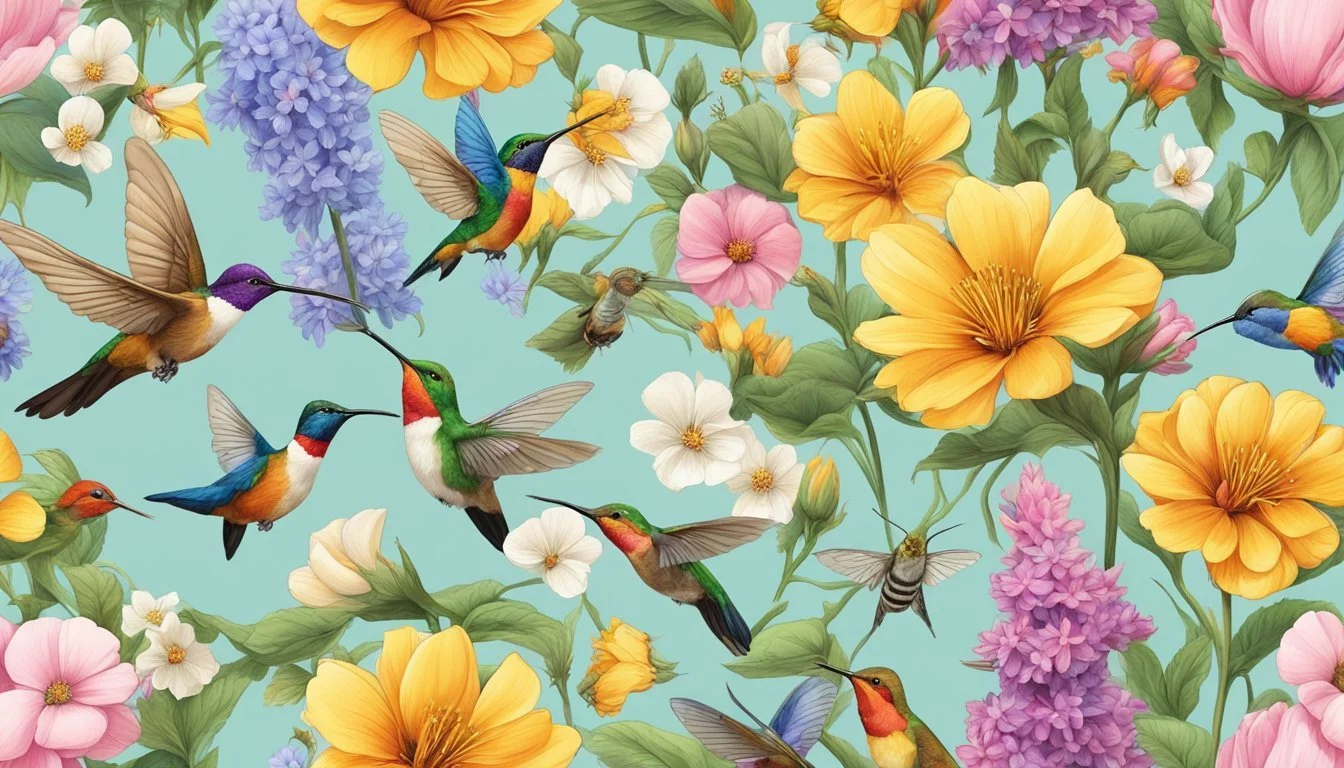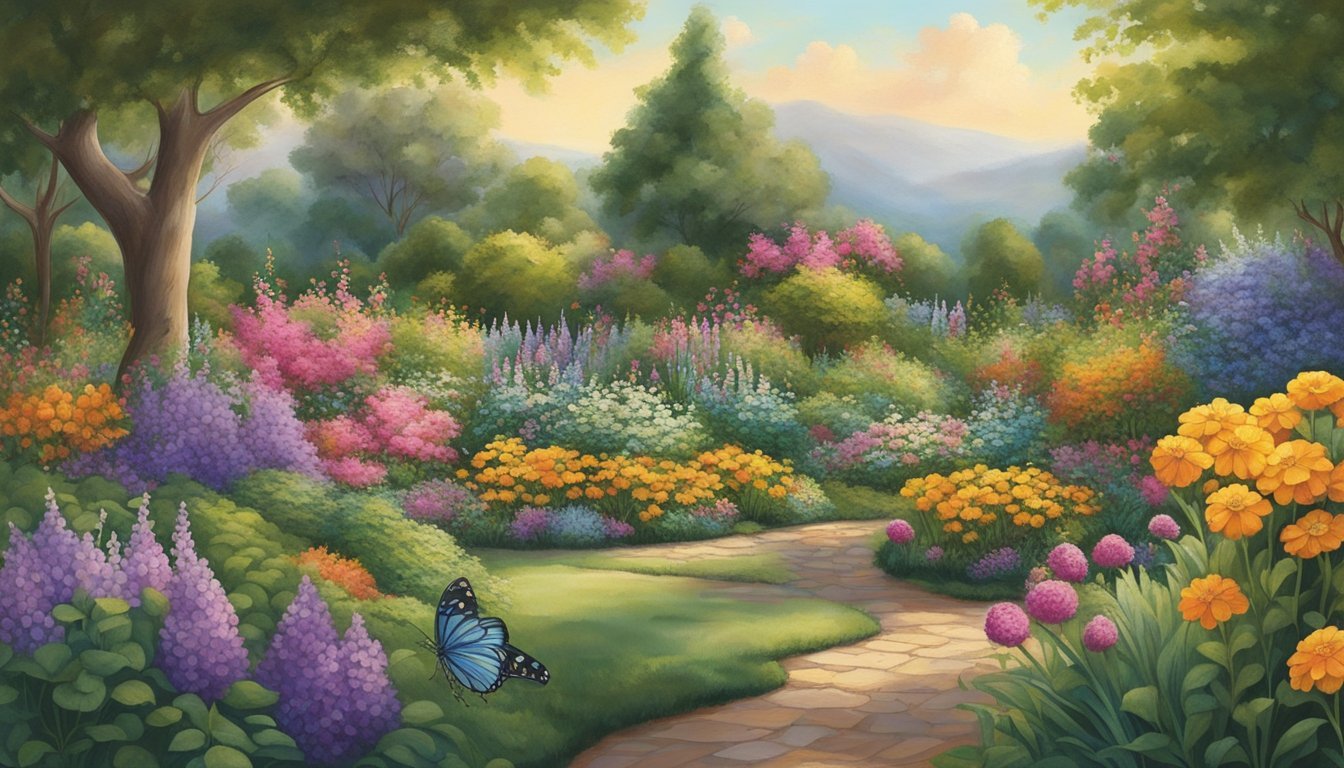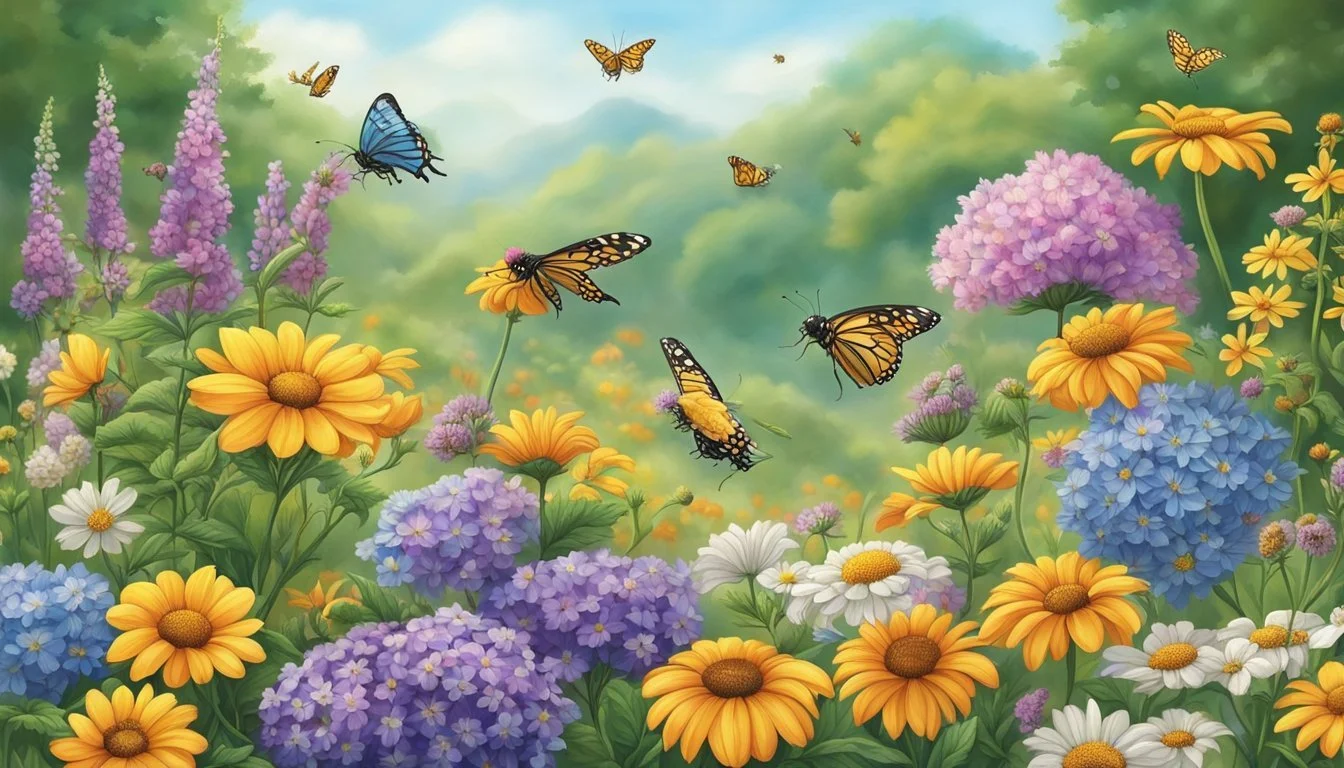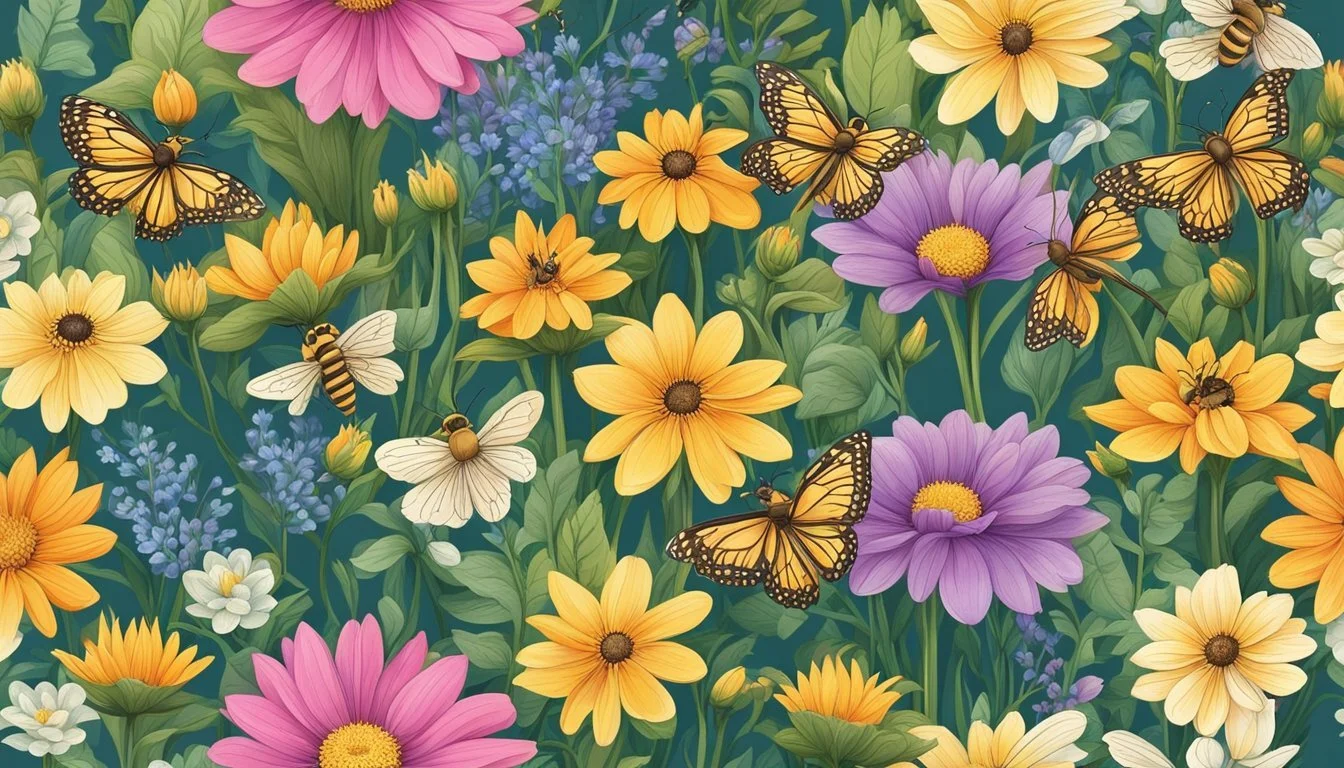Attracting Pollinators to Your Garden
Essential Plants and Practices
Attracting pollinators to a garden is essential for the health and productivity of plants. Pollinators include a wide variety of insects, birds, and bats, which are pivotal in the reproductive cycle of many flowering plants. By transferring pollen from one flower to another, they facilitate fertilization which leads to the production of seeds and fruit. Therefore, a garden teeming with pollinators not only contributes to plant diversity but also supports a robust ecosystem.
To create an enticing environment for pollinators, gardeners should focus on incorporating native plants that provide nectar and pollen. These plants are particularly appealing to local pollinator species because they have co-evolved, making them easier to access and more nutritious compared to non-native or highly hybridized plants. Moreover, they are well-adapted to the local climate and soil conditions, which aids in their growth and reduces the need for additional resources such as water and fertilizer.
Beyond plant selection, arranging plants in clumps rather than as individual specimens can create a more target-rich environment for pollinators. This strategy increases the efficiency with which these creatures can forage, thus making the garden a more attractive destination. Night-blooming plants expand the range of pollinators by drawing in nocturnal species such as moths and bats, enhancing the garden's pollination network even after the sun sets.
The Importance of Attracting Pollinators
Pollinators play a vital in the health of ecosystems and biodiversity. They facilitate the reproductive process of plants, ensuring the continuation of different species of plants and the production of seeds and fruits essential for numerous organisms.
Roles in the Ecosystem
Pollinators include a variety of creatures such as bees, butterflies, birds, and bats. They transfer pollen from one flowering plant to another, fertilizing the plants in a symbiotic relationship that allows for the production of seeds. This process is crucial for the reproduction of over 75% of the world's flowering plants, impacting the health of ecosystems worldwide.
Ecosystem services provided by pollinators:
Pollination: It leads to the generation of fruits, seeds, and other plant parts that serve as a food source for a wide array of wildlife.
Soil and water conservation: Flowering plants cultivated by pollination help to stabilize soil and manage hydrological processes.
Pollinator Populations and Biodiversity
The diverse actions of pollinators affect the genetic makeup of plants, contributing to biodiversity. With such a variety of pollinating species:
Each one often specializes in interacting with specific plants, which can lead to co-evolution and a rich diversity of plant species.
This relationship ensures that ecosystems have a variety of food sources, materials, and resources for other species.
Understanding Pollinator Varieties
In any garden ecosystem, the diversity of pollinators, ranging from bees to butterflies, plays a crucial role in plant reproduction. Understanding the nuances between different species and their life cycles can significantly enhance a garden's productivity and biodiversity.
Native vs Non-native
Native Pollinators are the pollinators that have evolved with the local flora over time. These species are naturally well-adapted to the local climate and often have symbiotic relationships with native plants. For example, native bees, such as bumblebees, mason bees, digger bees, and solitary bees, tend to be more efficient than honeybees in pollinating certain native flowers due to co-evolution.
Advantages of native beneficial insects:
Increased resilience to local climate conditions
Higher efficiency in pollinating native plants
Support local biodiversity by sustaining native plants
On the other hand, non-native pollinating insects may have been introduced to an area through human activity, either intentionally or accidentally. While some non-natives, like honeybees, are well-regarded for their pollination abilities and honey production, they can sometimes compete with native pollinators for resources.
Considerations for non-native pollinators:
Potential to outcompete native species
May require additional care or management
Role in pollinating introduced plant species
Pollinator Life Cycles
Understanding the life cycles of pollinators is essential for creating a garden that supports their needs throughout their development. Bees, for instance, have a complete metamorphosis lifecycle that includes the stages of egg, larva, pupa, and adult. Providing a habitat for these different stages is crucial. Ground-nesting bees require undisturbed soil, whereas wood-nesting bees need access to old wood such as dead trees, or bee hotels.
Lifecycle needs for bees:
Bare, undisturbed soil for ground nesters
Access to deadwood or nesting aids for woodnesters
To attract butterflies and moths, which also undergo complete metamorphosis, providing larval host plants is critical. As caterpillars, they are often plant-specific and need certain species to thrive. For instance, monarch butterflies require milkweed to lay their eggs, and the monarch caterpillars almost thrive exclusively on this plant. During the adult stage, these insects require nectar sources for energy. They are attracted to bright colorful flowers and tubular flowers with milder, fresh scents.
Lifecycle needs for butterflies and moths:
Plant-specific butterfly host plants for caterpillars such as butterfly weed (Asclepias), Black Eyed Susan (Rudbeckia)
Nectar-rich flowers for adults
Other pollinators like flies, wasps, and ants play roles in pollination, although they are less specialized. Hummingbirds and bats, as vertebrate pollinators, have distinct needs such as specific flower shapes and nocturnal blooming plants, respectively. Red and orange trumpet shaped blooms attract hummingbirds to drink nectar and pollen transfer for you.
Designing a Pollinator Paradise
Key elements to providing a pollinator-friendly habitat include the right location, a diverse selection of plants, and the strategic arrangement of these plants to ensure year-round blooming.
Choosing the Right Location
The ideal location for a pollinator garden offers abundant sunlight since most plants that attract pollinators need full to partial sun. The area should have access to water and protection from strong winds. Additionally, it's beneficial to include features like rocks, shrubs, and trees that can serve as potential nesting sites, ensuring a suitable habitat that supports the entire life cycle of various pollinators.
Native Plants and Flower Diversity
When selecting plants for a pollinator garden:
Native plants: Choose a variety of native plants that are well adapted to the local climate and soil conditions of your own backyard. Native plants tend to attract and support a wider range of pollinators due to their long-term co-evolution.
Flower diversity: Include plants with different flower colors, shapes, and sizes to attract a diverse group of pollinators.
Nectar-rich plants: Make sure to have a good proportion of nectar-rich flowers to provide ample food sources.
Plant Arrangement and Bloom Timing
Arrange plants in clusters to create a bold visual impact and allow pollinators to forage efficiently. Ensure blooming succession throughout the growing season to provide consistent food sources. This can be achieved by selecting plants with staggered bloom times:
Early bloomers: Provide food for early spring pollinators.
Mid-season bloomers: Sustain the majority of pollinating insects and migratory species.
Late bloomers: Offer resources for pollinators that are active until the first frost.
Considering the entire life cycle of pollinators when designing your garden enhances its effectiveness and ensures that it remains a lively and attractive habitat through all seasons.
Best Plants to Attract Pollinators
Attracting a variety of pollinators to a garden requires a careful selection of plants known for their appeal to bees, butterflies, and other beneficial insects. Specific pollinator plants offer nectar and pollen as vital resources for these creatures, planting nectar-rich plants alongside food crops is one the most fool-proof ways to attract pollinators to your vegetable garden.
Native Pollinator Plants
Native plants are especially important for local pollinators because they have co-evolved over time. For instance, milkweed plants are essential for monarch butterflies as their caterpillars feed exclusively on milkweed leaves. Many plants like New England aster and goldenrod support a wide range of insects, due to their familiar nectar and pollen.
The timing of blooms is crucial to provide a continuous food source for pollinators. Gardeners should plant in succession, for example, sunflowers, asters, and coneflowers all bloom at different times throughout the growing season. Incorporating flowers like lavender and wild bergamot not only adds a variety of bloom times but also provides ample nectar.
Borage, a blue-flowering herb, offers abundant nectar and can self-seed for future growth.
Lupine, with its spiky blooms, not only adds vertical interest but also is favored by many pollinators.
Herbs and shrubs serve dual purposes; they provide habitat while also supplying food.
Lavender stands out with fragrant leaves and flowers that attract an array of pollinators.
Robust shrubs like sunflower varieties offer a substantial structure for pollinators to land on and a copious amount of seeds and pollen.
By incorporating these plants into a diverse garden design, the garden not only bursts with color and life but also supports the crucial ecosystem services pollinators provide.
Pollinator Garden Maintenance and Seasonal Care
Garden soil acts as the foundation for plant growth and pollinator attraction. Regular testing of soil pH and nutrient levels allows gardeners to tailor fertilization practices to their garden's specific needs. Organic matter, such as compost or well-rotted manure, can be incorporated to improve soil structure and fertility, thus supporting robust plant growth which in turn entices pollinators.
Spring: Enrich soil with compost before the growing season starts.
Fall: Add mulch to protect soil and plant roots from winter cold.
Weed suppression is vital to prevent competition for resources needed by plants that attract pollinators. Mulching and hand pulling are effective, non-chemical methods of weed control that protect the beneficial insects. When it comes to pests, one should resort to the least toxic options first, only applying pesticides as a last resort, and preferably after pollinators are less active, like at night or during cold seasons.
Early Spring: Monitor for and remove any early weed growth.
Summer: Apply mulch to discourage weeds and retain soil moisture.
Plants have varying needs across different seasons, and timely care is essential for keeping them attractive to pollinators. Pruning dead or diseased foliage in early spring promotes healthy new growth. In fall, gardeners should trim perennials and plan for winter-hardy blooms to provide food sources when there are fewer options for pollinators.
Climate Considerations: Select plants that thrive in your local conditions for year-round appeal.
Winter: Leave some seed heads and dead plant material for shelter and food during the colder months.
Supporting Beneficial Pollinators
The key to a thriving garden is ensuring a habitat that supports beneficial pollinators. This includes providing a diversity of plant life and artificial nesting aids that cater to their needs.
Creating a Diverse Environment
A diverse environment is essential for supporting a wide range of beneficial pollinators. Native species should be the cornerstone of any garden aimed at attracting these vital insects. They are adapted to local pollinators and provide the necessary nectar and pollen.
Gardens should include a variety of host plants, which offer both adult and larval host plants for caterpillars and other developing pollinators. Choose plants based on bloom times to ensure a continuous bloom from early spring to late fall and supply consistent food sources, critical for their survival.
Spring: Early blooming plants like dandelions serve as a crucial food source for bees.
Summer: Plants such as Black-Eyed Susan and Purple Coneflower hit their stride.
Fall: Late bloomers provide sustenance just before many pollinators overwinter or migrate.
Artificial Nesting Aids
In addition to natural habitats, gardeners can provide artificial nesting aids to encourage pollinator habitation. Bee condos or drilled lumber pieces offer nesting sites for native bees. Planting flowers such as Agastache Bee Balm (Monarda) nearby will raise the value of the condos in the area.
When creating these aids, varying the hole diameter accommodates different species, with a depth of about 3 to 5 inches being ideal. This helps ensure that beneficial pollinators like bees have safe places to lay eggs and raise their young away from predators. It's important to place these aids in a location that's protected from the elements and where they won't pose a safety risk to passersby.
Regular maintenance of these structures is also important to prevent disease and parasites from affecting the pollinator population. By supplementing the natural environment with these man-made aids, gardeners can significantly increase the number of native bees and a variety of other pollinators that visit their gardens.
Enhancing the Pollinator Experience
Creating a haven for pollinators involves strategic use of color, pattern, and scent. By catering to their preferences and behaviors, gardeners can significantly improve the attractiveness of their gardens to beneficial pollinators.
Color and Pattern Diversity
Pollinators are attracted to a variety of colors and patterns. Gardens should integrate a broad palette of hues planting flowers in visible clumps to create a visual feast to attract bees and other insect pollinators. This method not only appeals to the sight of pollinators but also allows for easier navigation and more efficient foraging.
Floral Colors: Blue, purple, violet, white, and yellow
Patterns: Variegated or contrasting patterns on petals
Scented Plants and Night Bloomers
Fragrance plays a critical role in luring pollinators, especially those who are active at dusk or during the night. Incorporating scented plants that release their fragrance in the evening can attract nocturnal pollinators like moths.
Daytime Fragrances: Herbs such as lavender and rosemary
Night Bloomers: Flowers like evening primrose and night-blooming jasmine
Additional Ways To Attract Pollinators
In addition to planting a variety of flowers, providing water sources and shelters can significantly enhance a garden's allure for pollinators. These additions ensure pollinators are not only fed but also hydrated and protected against environmental stressors.
Providing Water Sources
To cater to the hydration needs of pollinators, gardeners should incorporate water features such as a shallow bird bath or water dishes. These sources of water are essential for pollinators like bees and butterflies. It's important to:
Use shallow containers with clean water.
Add stones or marbles to bird baths to create landing spots for insects.
Shelters and Hiding Spots to Encourage Pollinators
Creating shelters within the garden gives pollinators places to rest, hide from predators, and nest. This can be achieved by:
Leaving some areas of the yard undisturbed with leaf piles for nesting and hibernating.
Leaving dead trees for larval-stage pollinators
Installing structures like bee hotels or butterfly boxes to provide safe retreats.
Planting native shrubs and leaving dead wood and leaf litter to offer natural shelter.
Avoiding Common Garden Pitfalls
In creating a haven for pollinators, gardeners must navigate around detrimental practices that can undermine their efforts. Specifically, how they tackle pest control and plant selection in their veggie garden can have lasting impacts on the garden ecosystem.
Pesticides and Chemicals
Pesticides pose significant risks to beneficial insects in the garden including key pollinators. Gardeners should exercise caution, opting to control pests naturally, or at least, searching for the least-toxic options, and using them responsibly. For instance:
Spray Timing: Apply at night when pollinators are less active.
Targeted Application: Focus on infested areas to minimize widespread impact.
Alternatives: Use physical barriers or natural predators when possible.
Invasive Plants
The introduction of non-native plants can lead to unanticipated consequences, among them the spread of invasive species. These plants can outcompete and displace native flora, disrupting local pollinators' habitat. Gardeners must:
Identify: Learn to recognize non-native and invasive plants.
Prefer Natives: Choose local plant species that naturally support pollinators.
Monitor: Keep a vigilant watch for invasive species and remove them quickly.
By addressing these pitfalls, gardeners can significantly improve the health and attractiveness of their gardens for different pollinators.





